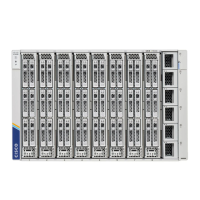

Do you have a question about the Cisco UCS X9508 and is the answer not in the manual?
| Total Slots | 8 |
|---|---|
| Supported Server Nodes | Cisco UCS X-Series Server Nodes |
| Number of Half-Width Slots | 8 |
| Number of Full-Width Slots | 0 |
| Storage Options | Dependent on server node configuration |
| Power Supplies | Up to 4 power supplies |
| Power Supply Redundancy | N+1 redundancy |
| Cooling | Hot-swappable fans |
| Chassis Management | Cisco UCS Manager |
| Dimensions (H x W x D) | 32.0 in (81.3 cm) |
Describes the Cisco UCS X9508 Server Chassis and its components within the Cisco Unified Computing System.
Details the advantages and capabilities of the Cisco UCS X9508 server chassis.
Provides an overview of the various physical components of the Cisco UCS X9508 chassis.
Explains the functions and types of Intelligent Fabric Modules (IFMs) in the chassis.
Covers the AC power supplies (PSUs) supported by the chassis and their configurations.
Explains the function and location of LEDs on the chassis and its components.
Provides crucial safety instructions and warnings before installing the chassis.
Specifies the necessary requirements for installing the chassis in a rack.
Provides instructions on how to safely handle the server chassis.
Guides the user through the process of installing the chassis into the rack.
Explains how to place the chassis into the installed rack rails.
Provides steps to safely remove the chassis from the rack.
Introduces the components that can be installed or removed from the chassis.
Guides on installing and removing compute nodes.
Instructions for installing and removing power supply units (PSUs).
Guides on replacing the Power Entry Modules (PEMs).
Covers installing and removing fan modules.
Guides on installing and removing Intelligent Fabric Modules (IFMs).
Information on how to recycle printed circuit boards.
Lists the physical dimensions and capacities of the chassis.
Provides environmental operating conditions for the chassis.
Lists the technical specifications for the chassis power supply units.
A checklist for preparing the installation site.
Worksheet to record contact and site details.
Worksheet to record chassis and module serial numbers.